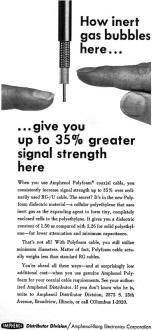|
January 1962 Radio-Electronics
 [Table of Contents] [Table of Contents]
Wax nostalgic about and learn from the history of early electronics.
See articles from Radio-Electronics,
published 1930-1988. All copyrights hereby acknowledged.
|
Amphenol's introduction
of Polyfoam® dielectric material for coaxial cable represented a
big improvement from both signal loss (attenuation) and velocity factor. This
1962 Radio-Electronics magazine advertisement promoted its virtues. Its
previous dielectric was solid polypropylene having a dielectric constant of
2.26, whereas Polyfoam® claimed 1.50. Velocity factor (VF) is
proportional to the inverse square root of the dielectric constant (k); i.e.,
VF = 1/√k. Hence VFpolypropylene = 0.620, and VFPolyfoam®=
0.816. The lower k value facilitates, for equivalent current handling, a smaller
coaxial cable diameter with a lower weight,
and is more flexible due to a "softer" dielectric. I could not find a breakdown
voltage value for Polyfoam®, as compared to polypropylene's
30 kv-40 kV. Calculation of the characteristic
impedance of a coaxial cable involves many parameters, all of which also
affect current, voltage and power handling, physical size, flexibility, minimum
bend radius, signal propagations velocity, capacitance, group delay, signal
attenuation, and more. Nothing's simple.
Amphenol Polyfoam® Coaxial Cable
 How inert gas bubbles here ... How inert gas bubbles here ...
... give you up to 35% greater signal strength here
When you use Amphenol Polyfoam® coaxial cable, you consistently
increase signal strength up to 35% over ordinarily used RG-/U cable. The secret?
It's in the new Polyfoam® dielectric material - a cellular polyethylene that uses
inert gas as the expanding agent to form tiny, completely enclosed cells in the
polyethylene. It gives you a dielectric constant of 1.50 as compared with 2.26 for
solid polyethylene - for lower attenuation and minimum capacitance.
That's not all! With Polyfoam® cable, you still utilize minimum diameters. Matter
of fact, Polyfoam® cable actually weighs less than standard RG cables.
You're ahead all these ways - and at surprisingly low additional cost - when
you use genuine Amphenol Polyfoam® for your coaxial cable requirements. See your
authorized Amphenol Distributor. If you don't know who he is, write to Amphenol
Distributor Division, 2875 S. 25th Avenue, Broadview, Illinois, or call Columbus
1-2020.
Amphenol Distributor Division / Amphenol-Borg Electronics Corporation
|



























